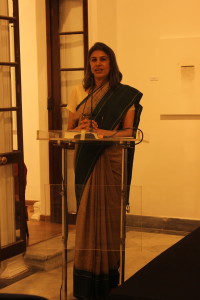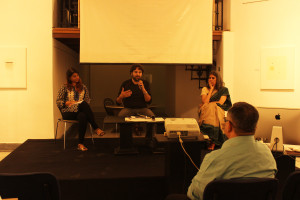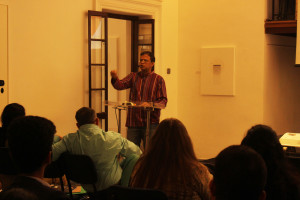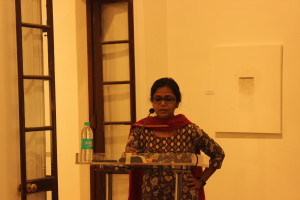Keynote Address
What the Nation really needs to know about JNU: Dissent, Sedition and the Difference it Makes
Janaki Nair
Janaki Nair teaches history at the Centre for Historical Studies, Jawaharlal Nehru University.
Janaki Nair began her keynote by sharing her experiences of being a part of curriculum and textbook development at the NCERT. NCERT books in 2005 showed a very deliberate attempt to be inclusive—bringing in multi-perspectives in the narrative and acknowledging the fact that there are numerous sources of history. The textbooks encouraged students to engage in the method of how historians think, departing from the narrative and moving onto a thematic telling of history. What is important is addressing these sources of history. Nair also said that one usable, teachable past is not a possibility and is therefore perhaps the biggest challenge in history teaching. This change in the textbooks, the content and the methodology, while significant, presented teachers with a new problem—their students were unable to prepare for exams, driving them back to the narrativized method of teaching.
Nair then went on to describe the events at JNU that had succeeded, not in the most ideal way, in bringing back the debate over nationalism into the public consciousness. Not only was the word nationalism on everybody’s lips but also its opposite as result of young scholars being branded anti-national and being arrested under the archaic Sedition clause—one that had been introduced by the colonial government. The reality at JNU, as Prof Nair said, was not one of disruption and hooliganism as wrongly depicted in the media. Teachers did go on strike, which lasted all of a day, after which campus life simply continued. Professors under instructions to not allow deviations from their normal routines, organised twenty-four ‘teach-ins’ after their day’s classes were over, in the iconic Freedom Square. Every talk was listened to with respect, recorded and put up on YouTube, reaching a wide audience. These teach-ins have been published in the form of three books in Kannada.
Nair then went on to read her introduction to a book based on the lectures on Nationalism at JNU that is due to come out soon. The aspect of language being a symbol of the nation was also touched upon by Nair using the example of official circulars in JNU, which are being sent out in Hindi—a complete antithesis to its pluralistic image. There is multilinguism, but of a restricted kind.
Session 1. Nationalism and the Left
Dreaming of Revolution: Student Politics and the Radical Left in 1960s Calcutta
Meher Ali
Meher Ali is a Fulbright research scholar from Brown University.
Meher Ali shared her ongoing research on the Left in Calcutta focusing on the period between 1966 and 1971. In lieu of sharing her analysis of the events of the period, Meher shared the stories she had collected as part of her research, as related by individuals who were a part of the political landscape of those times. Her interviewees described that period of time as a time of global crossroads with the unemployment crisis and the post partition alternative imaginings for the newly established state. Ali traced the student politics in Bengal, which was mostly leftist, of the time when reformism and revolutionary politics were in full swing in the state. In the span of a year from 1965 the number of student led rallies in the state grew from 271 to 607. Ali’s interviewees were not averse to the concept of the nation but that of the state. But their concept of the nation was an unclear one much like the state of their goals.
In Conversation: Tikender Singh Panwar, Janaki Nair and Meher Ali
Tikender Singh Panwar is the Deputy Mayor of Shimla.
Discussing the concept of nationalism that is currently playing out in Shimla, Tikender Singh Panwar spoke about the difference in the nature of the concept which has morphed from the inclusive nationalism of the pre-independence era to the exclusive ideal it is now. Differing with Menon that it was ever a virtuous entity, he explained how nationalism in India was different from that of the west where the nation came before its people. Commenting on the exclusionary tendencies of the present nationalism he mentioned how with the rise of bourgeoisie nationalism even use value services are being treated as exchange value commodities, leaving no conceptual difference between things such as education and a market commodity. He spoke of how in the last six months 173 Left activists had found their way to jail and how there is an ongoing attempt to privatise the water supply in Shimla.
Janaki Nair commented on the blindness of the Indian Left on certain fronts, which led to the creation of problematic politics such as the delayed acceptance of caste as a category. Referring back to Ali’s presentation on leftist politics in West Bengal in the 1960’s, she reiterated that despite the presence of the brightest of students within the Left there was no clearly envisioned future. As China remained the visionary horizon for the Left, they remained divorced from the local solidarity and despite knowing what they were against did not know what they were for. She spoke about the language movement in the south and the Dalit movement of the 1970s, which was inspired by the Left but did not find solidarity from the latter. She mentioned how Kanhaiya Kumar’s recent integration of the Dalit blue and the Left red had perhaps been too optimistic a statement based on a recent troubling slogan by the ßBAPSA, which essentially equated the Lefts and the Bhakts, as questions of caste are being ignored as a social reality or a political possibility by both. She further commented on the emerging student politics in the country wherein the language of revolutionary violence has been given up to instead invoke the constitution, adhering to civility.
The ensuing discussion raised the point of an inability to clearly articulate their thoughts despite the existence of a manifesto, eerily similar to the lack of clarity of thought in the extreme right wing youth of today.
Session 2. Is Nationalism a Dubious Construct?
A dialogue with Prof Anil Sethi
Anil Sethi opined that it will not do to be myopic about the concept of nationalism. Building a typology of nationalism he said that the concept is split between ethnic nationalism, cultural nationalism and religious nationalism on one hand and civic nationalism on the other. Drawing on Benedict Anderson, he pointed out that nationalism is not an ideology but a construct, mentioning that the erstwhile CPI (M) newsletter was called The Patriot. Concentrating on the sovereignty of the people, he discussed how subjects became citizens and how the nationalist studies, which started in the 1870s, traced the negation of dynastic sovereignty to a space where the people were re-empowered to participate. He questioned a complete rejection of nationalism without caution, championing civic nationalism which is inclusivist in nature and averse to a violent `war-mongering way of thought and explained how patriotism means political vigilance and participation in the criticism of the state. He spoke of the civic nationalism of Subhash Chandra Bose and the Gandhian narrative of the civic nation state insisting that we have to take the concept of nationalism down the civic nationalist route. In the ensuing discussion it was established that it is possible to build a nationalism incorporating non-confrontational, non- sectarian and inclusive values if it is developed independent of provocation.
Session 3. Nationalism and Popular Culture
Bollywood as Nationalist Cinema
Jerry Pinto
Jerry Pinto is author of Helen: The Life and Times of the H- Bomb and other books on Bollywood and cinema.
Jerry Pinto began his talk by stating that perhaps a space for building history cannot be restricted to academies or institutions alone, history is being made right now. History textbooks are easily forgotten. Which brings one to the question why should history be remembered? Who prioritizes what needs to be remembered? Jerry spoke of the fact that the system (educational) is a complete failure in terms of knowledge gained and therefore everything we learn is from outside the textbook.
Nationalism has become a shallow concept, and Jerry spoke about Bollywood being unashamedly shallow thereby presenting one with the ‘ideal formulation for the understanding of the nation-state’. Bollywood in all its shallow, seemingly disconnected way of seeing the world offers us a way out from the daily-ness of having to search for identity. Jerry mentioned a debate between Aamir Khan and Farrukh Dhondy about whether to call the film ‘Mangal Pandey’, Mangal Pandey or to call it a name that would signify the whole reason behind the Sepoy Mutiny—the usage of pig fat in cartilages. They did of course ultimately call it Mangal Pandey, thereby, observed Jerry, making the whole problem with the world based essentially on diet! Which is probably why Bollywood in all its escapist glory never shows food, or rather, ‘controversial’ food.
The world children look at is essentially divided into Gabbars and Veerus (the hero versus villain concept with a reference to popular Hindi film Sholay), which is the narrative they are given, when the reality as we know it is very different. It is therefore essential to first, as adults, implicate our own position in the continuum of history.
When the British censor board was still functioning in India, songs with a nationalistic sentiment, for example, in the film Kismat were passed. This was allowed only because the British said that this was a message they were sending to Germany or Japan. Jerry also spoke about the ‘Mother India’ image—one that is an all-sacrificing woman giving up her son and so on. The 1950s saw a surge of a nationalistic sentiment amongst filmmakers, and the 60s an explosion of the cotton-candy actor. Film making in Bollywood shows an ebb and flow, and as Jerry calls it, with each decade, a ‘sinusoidal curve’ that defines and re defines the nation state in subtle ways.
Sculpting the Citizen: History, Pedagogy and the Amar Chitra Katha
Deepa Sreenivas
Deepa Sreenivas is associate professor at the University of Hyderabad.
Deepa Sreenivas spoke about her paper on the Amar Chitra Katha (ACK) and its relation to pedagogy. Her work was done at a time when people in the academic sphere were forced to engage with the issues of caste and class due to the Mandal Commission protests. She spoke about the influence of Antonio Gramsci’s theories on her work—also connected to caste and class and the fact that cultural texts but connect with current social scenario.
In her paper, Sreenivas speaks of two claims: one, that the ACK history is a ‘presentist’ one and that it has a contemporary frame of reference, and two that in order to have such a frame of reference it has moved away from an academic notion of history.
Anant Pai started the ACK in the 70s when contradictions in the post Nehruvian state were becoming increasingly evident in terms of socio economic disparities—gender, caste and so on. The Right demanded a masculinization of the self, a discourse into which ACK inserted itself by creating a sort of masculine ideal. ACK was also projected as a counter to the western model or westernization.
Sreenivas spoke about the fact that while Amar Chitra Katha may or may not be considered as history per se, it is an ingrained part of middle class consciousness. It also signifies a revival of a so-called ‘indian-ness’, delving into myth, common sense and practicalities of everyday life. It has also articulated the definition of merit through its stories of great men.
For details of the speakers, please click here.
– Anushka Halder and Paroma Sengupta




